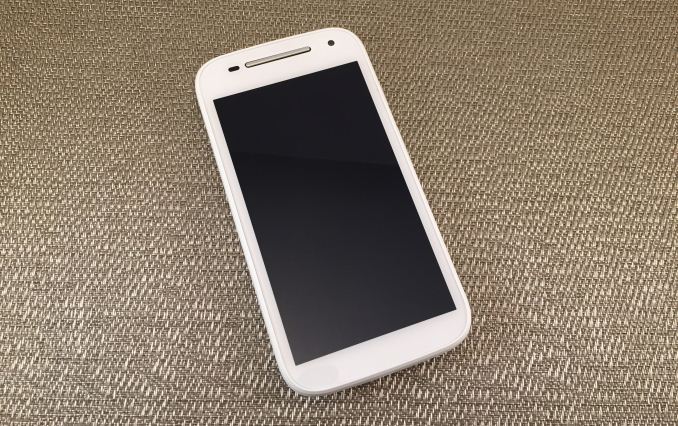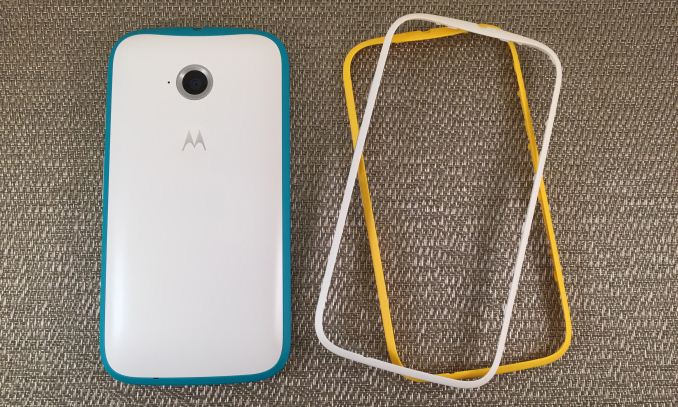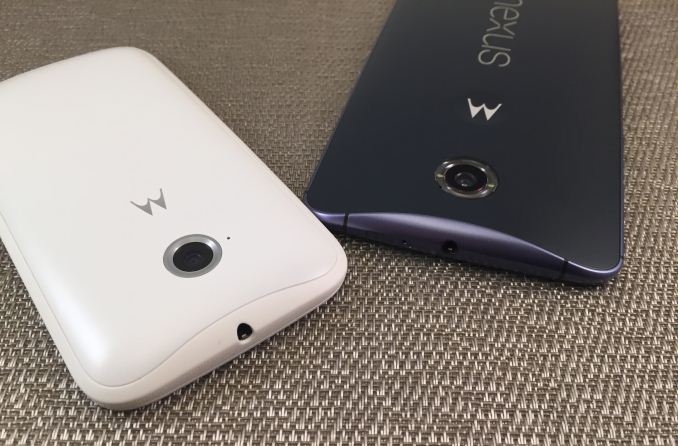The Moto E (2015) Review
by Brandon Chester on April 21, 2015 8:00 AM EST- Posted in
- Smartphones
- Motorola
- Mobile
- Moto E (2015)

During the past couple of years we've seen a dramatic shift in Motorola's strategy for competing in the smartphone market. As one of the earliest producers of Android devices, the company needed to let go of ideas and strategies from years that had since past. Producing exclusive devices for carriers like Verizon was no longer going to work with the iPhone finally freed from exclusivity on AT&T, and Motorola's hardware and software design had begun to show a great deal of age.
That brings us to today, at a point where Motorola has more or less found their new approach to making smartphones. It's a very simple and understandable approach. Consistency across the design of the hardware, consistency across the design of the software, and a yearly line of phones that can easily be divided into budget, mid-range, and flagship categories based on a single letter in their name. This review takes a look at the newest version of Motorola's budget device, the 2015 Moto E. Unfortunately, this year adds a bit of complexity to the simplicity of Motorola's smartphone line. Before getting into that, I've put the general specifications of the new Moto E below, with the original 2014 model as a point of comparison.
| Motorola Moto E (2015) (LTE model XT1527) |
Motorola Moto E (2015) (3G models) |
Motorola Moto E (2014) | |
| SoC | Qualcomm Snapdragon 410 (MSM8916) 4x Cortex A53 @ 1.2GHz Adreno 306 at 400MHz |
Qualcomm Snapdragon 200 (MSM8x10) 4x Cortex A7 @ 1.2GHz Adreno 302 at 400MHz |
Qualcomm Snapdragon 200 (MSM8x10) 2x Cortex A7 @ 1.2GHz Adreno 302 at 400MHz |
| RAM | 1 GB LPDDR3 | 1GB LPDDR2 | |
| NAND | 8GB NAND + microSD | 4GB NAND + microSD | |
| Display | 4.5” 960x540 IPS LCD | 4.3" 960x540 IPS LCD | |
| Network | 2G / 3G / 4G LTE (Qualcomm MDM9x25 UE Category 4 LTE) | 2G / 3G HSPA+ (MDM8x10) | 2G / 3G HSPA+ (MDM8x10) |
| Dimensions | 129.9 x 66.8 x 12.3mm 145g |
124.38 x 64.8 x 12.3mm 142g |
|
| Camera | 5MP (2592 х 1944) Rear Facing w/Auto Focus, F/2.2 aperture VGA (640x480) Front Facing |
5MP (2592 х 1944) Rear Facing w/Fixed Focus | |
| Battery | 2390 mAh (9.08Wh) | 1980 mAh (7.52Wh) | |
| OS | Android 5.0 | Android 4.4.2 | |
| Connectivity | 802.11 b/g/n + BT 4.0, USB2.0, GPS/GNSS | ||
| SIM Size | Micro-SIM | ||
On the cellular side, we have two HSPA models and 1 LTE model of the Moto E. There is an LTE version with UMTS bands targeted at the US market, a 3G-only version for the US market, and a global 3G version. The difference between the US and global 3G bands is the inclusion of the 1700MHz band for T-Mobile support on the US version, and the 900/2100MHz bands on the global version.
Design
Over the past couple of years, Motorola's hardware and software design has undergone some enormous changes. They shifted from producing heavily skinned and modified Android devices to using almost stock Google Android. Their industrial design similarly underwent significant changes, and a new style for their smartphones emerged with the original Moto X in 2013. The flat sides and edges of Motorola's old phones were replaced with continuous curves. This type of design is not only more ergonomic than Motorola's old devices, but also more unique and recognizable. It's very clear from the appearance of a Motorola phone that it is a Motorola phone, even without spotting the depressed logo on the back cover.
The Moto E is no exception to Motorola's industrial design. The back cover has a continuous curve that extends to all corners and meets with the phone's arched sides. The back of the phone has only a center-aligned 5MP camera and Motorola's standard indented logo. Unlike the original Moto E this back cover is no longer removable and customizable with different colors. Since the Moto E is a budget device, it also can't be customized with Motorola's Moto Maker. To add a level of personalization, Motorola has designed the phone so that the band around the edges is removable. Users can purchase a set of red, blue, and yellow bands for $20, and can swap them out with the default white or black bands as they please.
The band being removable creates a potential concern about the usability of the Moto E's buttons, as the part that you press down on is integrated into the bands themselves. During my time with the device I was actually surprised by how tactile the buttons felt and how little they wobbled considering that they were completely separated from the actual button mechanism. They definitely had more of a mushy feeling than the buttons on the Nexus 6, but they were still completely usable and actually better than I expected.
The removable bands also act as a great way to hide many of the ports on the device. Removing the band allows access to the Moto E's MicroSD slot and Micro-SIM port. The SIM slot is spring loaded, but it's so deep that anyone without very long nails will end up having to use a small object to press on the end of the SIM to remove it anyway.
The left side of the device has a tag which is attached internally and has FCC and regulatory information on it, as well as the device's IMEI.
I'm quite happy with the direction Motorola has gone in with regards to design. The basic design of a Motorola phone scales down to $150 devices and all the way up to $700 devices, and on all of them it's visually appealing as well as ergonomic. The material quality definitely takes a step down when you go for those budget devices, with the Moto E sporting a plastic outer band instead of the metal ones on the Moto X and Nexus 6. Despite that, the phone still feels well made and the matte plastic back actually feels just as nice as the one on the Nexus 6. If anything, Motorola might want to worry about their flagship devices not offering enough of an improvement over the very good build quality and materials of their budget offerings.













90 Comments
View All Comments
Brandon Chester - Tuesday, April 21, 2015 - link
That's a really bad mistake I commonly make. Thank you for pointing it out. Also the Moto E should be on the basemark chart, it might have glitched out and not regenerated or something. Let me take a look at it.mayankleoboy1 - Tuesday, April 21, 2015 - link
I have the MotoE 1st gen. I have only 2 complaints:1. The internal storage is too low at 4gb. I cant install many apps.
2. The gallery app takes a long time to sharpen zoomed images.
PsychoPif - Tuesday, April 21, 2015 - link
I'm happy to see you got some Windows Phone in there. While there is newer alternatives at this price, it's nice to see the diversityPeichen - Tuesday, April 21, 2015 - link
Overpriced when comparing with Chinese phones that have way better parts for the same price. The only reason Moto charge as much as it does with the the X, G, E and speciality phones is because it is the only American Android phone and if you want to buy American you have to pay the premium.Daniel Egger - Tuesday, April 21, 2015 - link
> Overpriced when comparing with Chinese phones that have way better parts for the same price.And which phones would that be? At least there're no brand phones at that price tag with this (hardware) feature set and then we haven't even talked about software yet; it's close to impossible to find a phone which is available with (mostly unadultered) Lollipop and given that many or even most vendors in this price segment do not even care to offer *any* updates that's a major factor for any sane person. Also Motorola is one of the few companies which allow for easy rooting and even bootloader unlocking -- that's no small feat.
I totally agree with Brandon that the only reasonable price/performance competition can be found in the Windows Phone camp.
Peichen - Tuesday, April 21, 2015 - link
Xiaomi Redmi 2 is $112 with Snapdragon 410, 1 or 2GB of RAM, 8 or 16GB of storage, 720p 4.7" screen, 8mp and 2mp camera and Android 5.0Daniel Egger - Tuesday, April 21, 2015 - link
Aha, I can't find it for less than $132 (the 1GB/8GB version). Here in Europe the cheapest price is 40€ more expensive then the Moto E 2nd Gen LTE. Also MIUI v6 is based on KitKat and 32bit so not really interesting.Impulses - Tuesday, April 21, 2015 - link
Not sure why the slightly xenophobic tinge is necessary... It might be designed in the US but I'm pretty sure no Moto phone is made there anymore (they closed the Texas assembly plant no?) and Moto's parent company is Chinese anyway (unless Lenovo decided to move).Moto has better distribution than Xiaomi etc, particularly within regions that Anandtech's readership is at, get over it. That isn't even saying much considering how woeful Moto's distribution and site are, but it's still a fact. I'd actually love to see some Xiaomi reviews but if I can't easily buy one it's pointless.
Nothing against them, I've got a pair of Xiaomi Pistons that are some of the best IEM I've tried under $70, if not the best (and they were $25).
blzd - Thursday, April 23, 2015 - link
If you actually try and buy an imported Chinese phone you end up paying a lot more then their MSRP, often more then double.Also who wants to use an Android interface that was never designed to be used with the English language?
RealTheXev - Wednesday, April 29, 2015 - link
I just picked up the LTE version of this phone for my mother on Verizon Wireless (and yes, I am 100% sure it is the 2015 model). It comes setup for pre-pay plans and has a bargain basement price of $69 (at Walmart no less). I even read on XDA of a few people being able to add it to their post paid Verizon plans simply by calling Verizon.For THAT price, its a freakn' sweet phone and its a huge upgrade over my mom's something LG with Android 2.6 3G (it was soo old.. and it was only a year old.. not even worth looking up the model # lol).